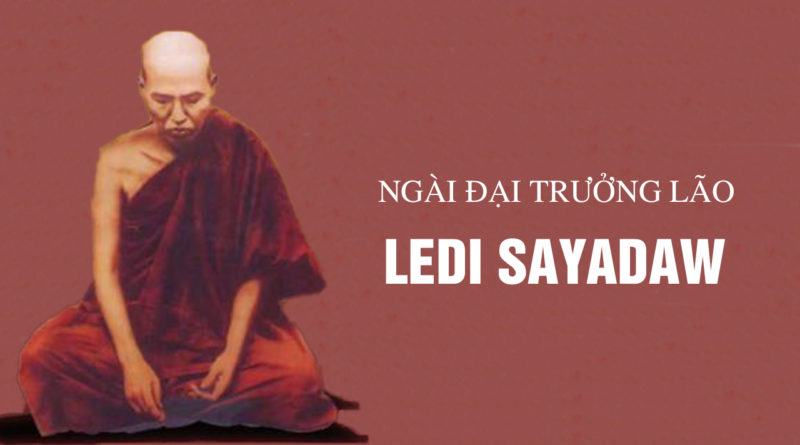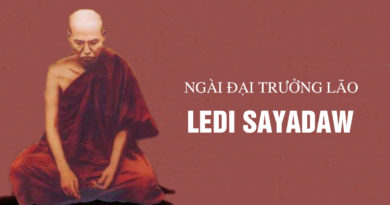A Manual Of The Dhamma – Legal Status Of Immoral Monks – Ledi Sayadaw
Legal Status of Immoral Monks
An immoral monk, at the time of his confession, becomes free from the stigma of “immoral” by renouncing his monkhood. However, an immoral monk may refuse to admit his guilt, and continue to live as a monk. Is he still a monk? Is this immoral person still a monk before the time of admission of guilt? The answer is that he retains the appearance of monkhood, but with the stigma of immorality. He is still a monk, though in appearance only.
The answer is correct. Evidence can be found in the Vinaya Piṭaka. In the Saṅghādisesa rules an immoral monk may claim that he is still a monk, although he has committed an offence of defeat. If he does not confess his fault he is still in possession of “paṭiññā,” that is, he retains the idea “I am a monk.” If a monk accuses him of defeat, without seeing, hearing, or suspecting anything, he is just as guilty as if accusing a scrupulous monk, and falls into a Saṅghādisesa offence. If a monk makes such accusations regarding an immoral novice, he falls into an offence of wrong doing. This is the first proof of the correctness of the answer.
If a monk dwells under the same roof for more than three nights with a layman or a novice, he is guilty of an offence of pācittiya. However, if he lives in the same dwelling with a fallen monk there is no offence, so it as if he were a genuine monk. The reason is that the outward sign of monkhood is still present in the immoral monk. This is the second proof for the correctness of the answer.
If a monk abuses a layman or novice, it is an offence of wrong-doing. If a monk abuses a fallen monk, who has not confessed his guilt, the abuser falls into an offence of pācittiya. In this case abusing a fallen monk is equivalent to abusing a genuine monk. This is further proof of the effect of an immoral monk claiming a monk’s status.
Neither a layman nor a novice fulfils the requirements for conveying one’s purity to the Saṅgha (chanda-parisuddhi),⁵ but a fallen monk does because the outward appearance of monkhood is present. This is yet another proof.
So it is clear that although he not a true monk, an outward sign (liṅga), or idea (paṭiññā) exists because of the power of Vinaya.
Although an immoral, fallen monk has committed one of the gravest faults, if he still claims that he is a monk, his status is just like a true monk. How is this possible? This monk receives the power and command of the Buddha’s Vinaya when, at the time of his ordination, he asks for and receives the robes from his preceptor. This itself is a Vinaya power of the Buddha. Secondly, he has gone through the five Vinaya procedures, such as declaration by the Saṅgha (ñatti) following rules laid down by the Buddha. So, despite breaking the gravest rule, he retains the outward appearance of monkhood due to the two features he received from the Vinaya procedure, and they retain their power until his voluntary confession.
This is surprising, but correct. Once a layman asks for and receives robes from his preceptors according to the Vinaya rules, he immediately transcends the lower status of a layman. Upon taking the three refuges and accepting the robes in the way prescribed by the Vinaya, he immediately becomes a novice. This is due to the power of the Buddha’s command. Just asking for and receiving robes elevates him to a higher status than a layman, even if he fails to receive the three refuges for lack of a suitable preceptor. If he remains in this position, he is more honourable than a layman because by this one procedure he attains the features and status of one gone forth.
For bhikkhu ordination, four kammavācā recitations⁶ are mandatory to achieve the full status of a bhikkhu. Yet even a single kammavācā recitation is sufficient to raise the candidate to the status of a novice. He now achieves, under the power of the Vinaya procedure and ceremony, the status of one gone forth. As the kammavācā recitations are completed up to the fourth round, his gone-forth status is repeatedly established. If the preceptors, for unavoidable reasons, stop their ordination procedure at the third recitation, this person is much higher in status than a novice although he lacks full bhikkhu ordination. He now receives the features or honours of a homeless life praised by the Buddha. If the fourth kammavācā recitation is completed, it raises him up to the full status of one gone forth, as a full bhikkhu in the Saṅgha.
If a novice breaks one of the ten training rules for novices, he destroys both the maintenance of three refuges and his status of a novice. However, while retaining the robes, he cannot be classified as a layman. He remains in the position of a novice. Once he discards the robes, he is deemed to be a layman.
An offence of defeat committed by a monk destroys him as a genuine monk, but he does not fall into the category of a novice or a layman yet. His monk status remains if he retains the appearance of this status. Once he renounces the appearance then he must be classified as a layman. All traces of monkhood now disappear, even the outward sign of wearing the robe.
An analogy is given here. If a scrupulous monk renounces his Vinaya obligations before the Saṅgha in the proper way, he becomes a layman again. Similarly, a fallen monk renounces his monk status by discarding his robes, thereby becoming a layman in the full sense. Due to the power of the Buddha’s command, this fallen monk maintains his monk status if he retains the outward appearances of a monk. However, he is an immoral, fallen monk due to his serious fault. When he confesses his offences and renounces his outward appearance, he becomes a layman. As a layman, he now escapes from the charge of being an immoral, depraved monk. The main point here is that if he does not discard his robes, even if he confesses his offence, we cannot classify him as a layman yet.
According to the Vinaya, if a monk abuses a fallen monk without just cause, it is just like abusing a scrupulous monk. The resulting offence is the same as abusing a scrupulous monk, and the accuser commits a serious (saṅghādisesa) offence. By understanding this subtle point, it is clear that slandering a fallen monk is worse than slandering a scrupulous layman. This is because the accused still claims to be a monk. Retaining the outward sign of a monk keeps him under the power of kammavācā; thus he is still under the power of the Buddha, Dhamma, and Saṅgha too. It is not because of his serious misdeeds, but because of the power of his ordination kammavācā, which is under the sublime influence of the Triple Gem. His acceptance of this declaration and his retention of the robe give him these powerful refuges. He retains a certain status.
However, these powerful refuges cannot save him from serious evil kamma, and the resultant suffering. By his commission of an offence of defeat, and his disgraceful claim to be a monk, he gathers evil kamma day by day. In other words, his evil kamma increases if he remains in these sacred shelters. Moreover, those who abuse an immoral monk accumulate serious evil effects themselves, due to this awkward situation. Those who appreciate the power of Vinaya show respect to an immoral, fallen monk, getting great merit. These three effects must be noted carefully.



